Stories
Golden Shears Awards
1961-1964
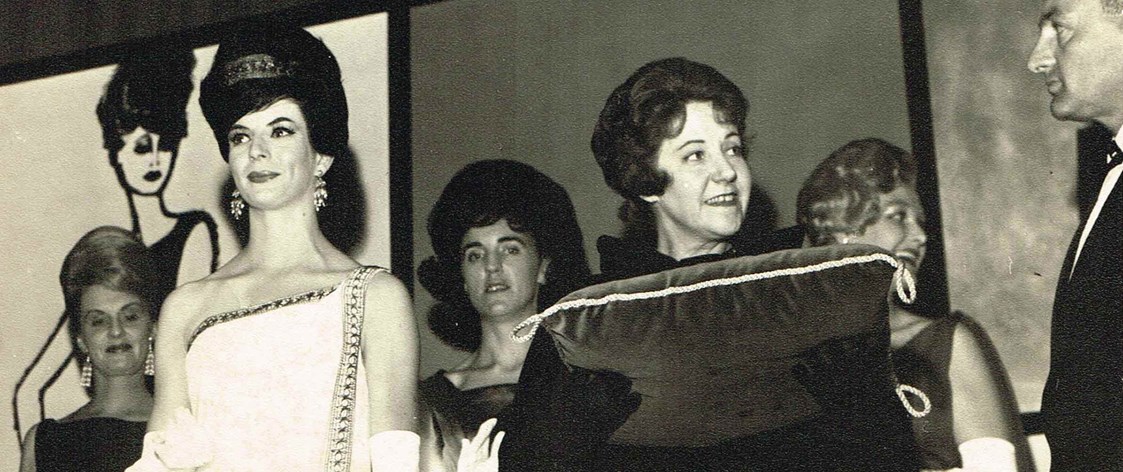
For four years in the early 1960s, New Zealand’s top designers competed in a fashion show and competition organised by fashion models - the New Zealand Professional Mannequins Association.
Not to be confused with the Golden Shears shearing competition that also started in 1961, the fashion awards were a glamorous affair designed to raise money for various charitable organisations. The event began as a way to manage the many requests that models of the era received to donate their time for charity fashion parades. The Professional Mannequins Association aimed to professionalise their trade by supporting models in what was a rapidly growing industry.
Elaine Hammond had modelled in Sydney for a year and, realising the value of the Australian Model Association, she mooted the idea of a New Zealand version when she returned home. A committee was formed and Elaine was voted president. "I chose to limit my modelling schedule to put time and effort into this venture," she recalls. With membership rapidly growing, the association was well-established by the time of their first large event in 1961.
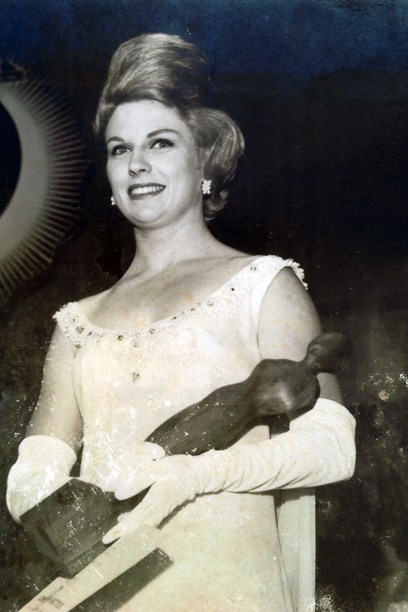
Elaine Hammond organised the first Golden Shears Awards in 1961.
The inaugural Golden Shears Awards (called The Fashion Spectacular in its first year) took place on 26 September at the Auckland Town Hall. The Auckland Council’s Community Chest Appeal was selected as the charity they would support and the event was backed by the Auckland Mayor Sir Dove Myer Robinson. Local retailers and manufacturers provided sponsorship for the event, including Middew Bros and Taylor Limited’s gift of a gallon of 'Intimate' perfume by Revlon. "The perfume was sprayed throughout the venue using a vacuum cleaner," recalls Elaine. "It created the perfect atmosphere for the evening." The glamour of the event was enhanced by lighting, music and the larger-than-life fashion posters that decorated the stage and catwalk.
The programme for the inaugural Golden Shears Awards in 1961.
Many of New Zealand’s top designers entered the awards, including Colin Cole and Rosemarie Muller. The garments were paraded by 18 models. The Master of Ceremonies was Berin Spiro, owner of the Auckland Model Agency and Charm School, and the various categories were compered by broadcaster Cherry Raymond (leisure wear), fashion writer Marie Stuttard (race wear) and fashion promoter Paddy Walker (gala gowns). The judges were brought over from Australia - the editor of Vogue Australia, Joan Chesney Frost and New Zealand-born and trained designer, Hall Ludlow.
The winning gown for 1961 was designed by Bruce Papas and modelled by Ana Nielson. The gown, called Golden Peacock, featured black velvet faconne heavily embroidered with gold over a black velvet sheath. "Its simplicity, dignity and style set it in top place," said Hall Ludlow. As the winner, Bruce was presented with a pair of engraved golden shears.
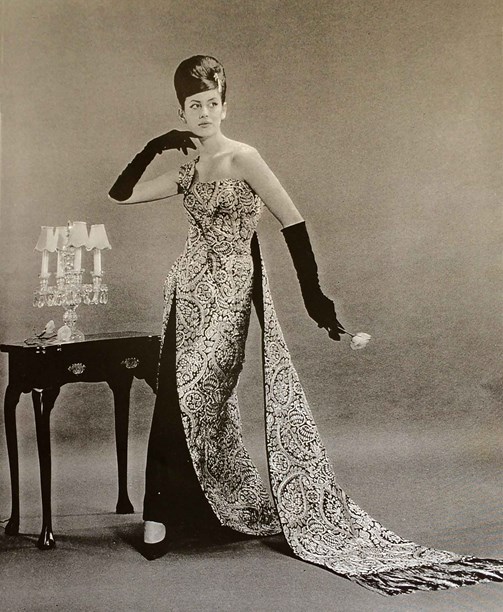
In 1961 Bruce Papas won the inaugural Golden Shears Awards with his Golden Peacock gown.
The stage had been set for a repeat gala in 1962. Bruce Papas returned to the event, this time as a judge. He was joined by the Australian designer Robert White for a two-night extravaganza on 10 and 11 November. The second night’s presentation included the announcement of the Model of the Year, which was selected by fashion photographers, manufacturers, designers and retailers taking part in the contest. The winner in 1962 was Elaine Hammond.
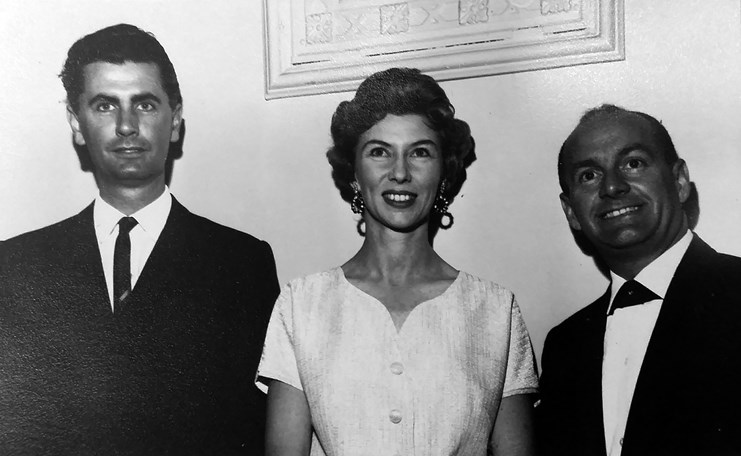
The judges of the 1962 awards - Bruce Papas, Marie Stuttard and Robert White.
Peggie Wilson won the 1962 Golden Shears Award for gala gowns with her entry, Venus. Worn by Anne Lynch, the gown was a Grecian style in white crepe with a jacket that clasped at the shoulder and banded with a classic key pattern in gold. Taumarunui designer Michael Mattar was awarded second place in the evening wear category and Joan Talbot of Tarantella won a Silver Shears award for leisurewear with a black and white poncho outfit.

The Venus evening gown modelled by Ann Lynch.
The 1962 awards were important for two other Auckland designers. Barbara Herrick of Babs Radon received her first competitive recognition when she was highly commended for her entry. Annie Bonza, who was working as a designer at Pour Vous, was also highly commended for a black and white satin gown that was trimmed with fabric violets. When Annie left Pour Vous to travel to Sydney, she was employed by Robert White, who had judged her entry.
A green satin gown embellished with crystals designed by Joan Scott of Rosemarie Muller Ltd, won the Golden Shears Award in 1963. The gown was modelled by Else van den Muysenbergh.
In 1964 the Golden Shears were held at a smaller venue, Oakley Lodge. The judges were June Dally Watkins of the Sydney modelling agency, and Graham R Roche who was the manager of the retail complex 246 Queen Street.
Joan Talbot won the Golden Shears award with a wool gown and cape with plisse pleats. The gown was later worn by Jan Furness (nee Barkley) in the Miss New Zealand and Miss International contests. Barbara Herrick won the Silver Shears for racewear with a linen dress and coat that was modelled by Elaine Hammond. Tina Grenville won the model of the year award.
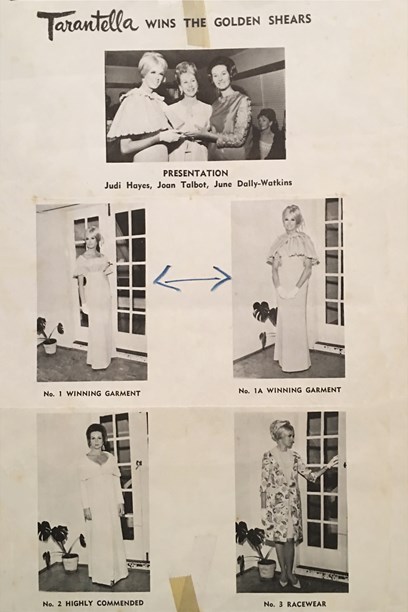
The winning designs of the 1964 Golden Shears Awards.
But 1964 was to be the final year of the Golden Shears. Elaine resigned from the position of organiser as she was now a busy mother of two and no one stepped up to replace her. Its end was also perhaps the result of the youthquake - where the values of elegance and sophistication in fashion were being replaced by fun, exuberance and a youthful spirit. The Auckland Star was not impressed with the new look of entries in the 1964 event, reporting that there was no "medium way" in the designs. "Clothes were either elegant and looked attractive on the models … or they were off-beat, kookie enough to shock even Mary Quant or Emmanuelle Khan. The extraordinary off-beat garments defy description. But the good taste clothes were the winners," (30 October 1964).
The new generation of designers began to shun the formal fashion parades and awards instead showing their clothes in coffee bars and at 'happenings' to the sound of the latest rock music. Using friends rather than professional mannequins, designers like Wendy Ganley organised live bands to play while the models danced on the stage wearing pantsuits and crocheted minidresses.
But for the winners of a Golden or Silver Shears award, the honour provided an invaluable boost to their design careers, and to the perception of the industry as a whole. "It made people feel prestigious - and that there was a fairly high standard of fashion in New Zealand," says the 1961 winner Bruce Papas.

The Golden Shears presented to Bruce Papas by the Auckland Branch of the New Zealand Mannequins Association, 1961. Image © Auckland War Memorial Museum Tāmaki Paenga Hira. 1999.2.14.
The founder of the awards, Elaine Hammond, agrees. "The success and standard of the Golden Shears brought class and elegance to both the modelling world and the fashion industry."
Text by Kelly Dix. Banner image © New Zealand Mannequins Association.
Last published November 2018.